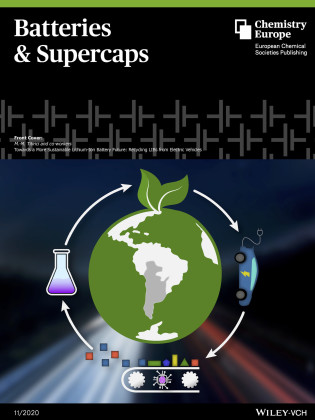Current projects
Lead researcher: Dr Laura Lander
PI’s: Dr Jacqueline Edge and Dr Gregory Offer
Funding:
- Faraday Institution Multi-Scale Modelling project (EP/S003053/1, grant number FIRG003)
In the efforts to establish net-zero emission transport and energy sectors, lithium-ion batteries play a key role in enabling electric vehicle (EVs) and the integration of renewable energies in the electricity grid. In order to accelerate the adoption of EVs and grid-storage, and to increase their environmental benefits, the life cycle cost and environmental footprint of lithium-ion batteries are decisive factors. Therefore, in this project, we aim to identify engineering solutions that decrease the battery life cycle cost and carbon footprint. To this end, the different steps of the battery value chain from manufacturing through use to recycling are evaluated using techno-economic and life cycle assessment tools.
Collaborators:
- ESE group - Department of Chemical Engineering: Prof Magda Titirici
- Department of Earth Science and Engineering: Mr Evangelos Kallitsis and Prof Anna Korre
- Newcastle University: Prof Oliver Heidrich
- University of Birmingham: Prof Emma Kendrick, Prof Robert JR Elliott and Dr Viet Nguyen-Tien
Funding:
- Innovate UK project SpeComBat (Specialised Commercial Batteries, 10006364). 2021-2022
Addressing the challenges of planning for a zero emission fleet, the ESE group is working with the London Fire Brigade and Williams Advanced Engineering to undertake the development of a sustainable battery pack for next-generation emergency vehicles. The project is a feasibility study, and will deliver a battery design, business case and supporting technical analysis, to create a compelling product for future development.
Collaborators:
- ESE group - Mechanical Engineering
- Williams Advanced Engineering
- London Fire Brigade
Publications:
-
Lander L, Kallitsis E, Hales A, Edge J.S, Korre A, Offer G, 2021, Cost and carbon footprint reduction of electric vehicle lithium-ion batteries through efficient thermal management, Applied Energy, Vol: 289, Pages: 116737.
-
Lander L, Tagnon C, Nguyen-Tien V, Kendrick E, Elliott RJR, Abbott AP, Edge JS, Offer GJ, 2022, Breaking it down: A techno-economic assessment of the impact of battery pack design on disassembly costs, Applied Energy, Vol: 331, 120437
Recent publications, 2020 - to date
Lander L, Tagnon C, Nguyen-Tien V, Kendrick E, Elliott RJR, Abbott AP, Edge JS, Offer GJ, 2022, Breaking it down: A techno-economic assessment of the impact of battery pack design on disassembly costs, Applied Energy, Vol: 331, 120437
Lander, L, Cleaver, T, Rajaeifar, M.A, Nguyen-Tien, V, Elliott, R.J.R, Heidrich, O, Kendrick, E, Edge, J.S, Offer, G, Financial Viability of Electric Vehicle Lithium-Ion Battery Recycling, iScience 2021, 24, 102787
Lander L, Kallitsis E, Hales A, Edge J.S, Korre A, Offer G, 2021, Cost and carbon footprint reduction of electric vehicle lithium-ion batteries through efficient thermal management, Applied Energy, Vol: 289, Pages: 116737.
Chitre A, Freake D, Lander L, Edge J, Titirici MM, 2020, Towards a More Sustainable Lithium‐Ion Battery Future: Recycling LIBs from Electric Vehicles, Batteries & Supercaps, Vol: 3, Pages: 1 – 12
Our paper featured as a cover page in Batteries & Supercaps
Our paper on a More Sustainable Lithium-Ion Battery Future featured as a cover profile in Batteries & Supercaps - Nov 2020
Chitre A, Freake D, Lander L, Edge J, Titirici MM, 2020, Towards a More Sustainable Lithium‐Ion Battery Future: Recycling LIBs from Electric Vehicles, Batteries & Supercaps, Vol: 3, Pages: 1 – 12
Lithium-ion batteries are a key enabler for environmentally beneficial technologies in both energy and mobility and, consequently, the market for lithium-ion batteries is predicted to grow significantly in the next two decades. However, lithium-ion batteries can only truly deliver on their promise for clean technologies if the sustainability issues in the current battery lifecycle are addressed. There are a number of ways this can be tackled, but it is important to consider each strategy from a whole systems perspective and to identify trade-offs between environmental and battery performance factors. For example, in order to make batteries easier to recycle, it may be necessary to change the materials or the cell and pack configurations to accommodate disassembly and these changes may incur a reduction in energy or power performance. From a whole lifecycle cost perspective, this reduction may be acceptable, but identifying the factors and their breakeven points requires more research. At present, the environmental impact of battery improvements is rarely taken into account and more work is needed to incorporate sustainability factors into cell design.

